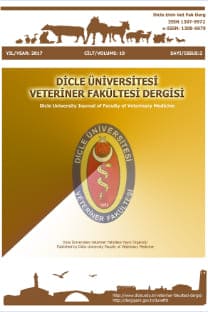Kuzu ve Oğlak Akut Koksidiyozisinin Tedavisinde Toltrazuril’in Tedavideki Etkinliğinin Değerlendirilmesi
Koksidiyozis, kuzu ve oğlak, tedavi, toltrazuril
The Evaluation of Therapeutic Efficacy of Toltrazuril in the Treatment of Coccidiosis of Lambs and Goat Kids
Coccidiosis, lamb and goat kid, treatment, toltrazuril,
___
- 1. Çimtay İ, Sevgili M. (2003). Koksidiyozisli Kuzularda Tedavi Öncesi ve Sonrası Bazı Hematolojik ve Biyokimyasal Parametreler Üzerine Araştırmalar. Van Vet J. 4: 91-94.
- 2. Gauly M, Reeg J, Bauer C, Erhardt G. (2004). Influence of Production Systems in Lambs on the Eimeria Oocyst Output and Weight Gain. Small Rumin Res. 55(1-3): 159-167.
- 3. Tafti AK, Mansourian M. (2008). Pathologic Lesions of Naturally Occurring Coccidiosis in Sheep and Goats. Comp Clin Path. 17(2): 87-91.
- 4. Taylor MA, Coop R, Wall RL. (2007). Veterinary Parasitology. Third ed. p. 175-178: 189-190, Blackwell Publishing Ltd.
- 5. Turgut K, Ok M. (1997). Veteriner Gastroenteroloji. Bahçıvan-lar Basımevi. Konya.
- 6. Jalila A, Dorny P, Sani R, Salim NB, Vercruysse J. (1998). Coccidial Infections of Goats in Selangor, Peninsular Malaysia. Vet Parasitol. 74(2-4): 165-172.
- 7. Öcal N, Yagci BB, Duru SY, Kul O. (2007). Toltrazuril Treatment for Acute Clinical Coccidiosis in Hair Goat Kids: Clinical Pathological, Haematologic and Biochemical Findings. Med Wet. 63(7): 805.
- 8. Diaferia M, Veronesi F, Morganti G, Nisoli L, Fioretti DP. (2013). Efficacy of Toltrazuril 5% Suspension (Baycox®, Bayer) and Diclazuril (Vecoxan®, Janssen-Cilag) in the Control of Eimeria Spp. in Lambs. Parasitol Res. 112(S1): 163-168.
- 9. Gul A. (2007). The Prevalence of Eimeria Species in Goats in Iğdır. Turk J Vet Anim Sci. 31(6): 411-414.
- 10. Hashemnia M, Khodakaram-Tafti A, Razavi SM, Nazifi S. (2014). Hematological and Serum Biochemical Analyses in Experimental Caprine Coccidiosis. J Parasit Dis. 38(1): 116-123.
- 11. Chartier C, Paraud C. (2012). Coccidiosis due to Eimeria in Sheep and Goats, a Review. Small Rum Res. 103: 84-92.
- 12. Maratea KA, Miller MA. (2007). Abomasal Coccidiosis Associated with Proliferative Abomasitis in a Sheep. J Vet Diagn Invest. 19(1): 118-121.
- 13. Cartier C, Pellet, MP, Pors I. (1992). Effects of Toltrazuril on Oocyts Discharge and Growth in Kids with Naturally –Acquired Coccidial Infection. Small Rumin Res. 8: 171-177.
- 14. Mundt HC, Dittmar K, Daugschies A, Grzonka E, Bangoura B. (2009). Study of the Comparative Efficacy of Toltrazuril and Diclazuril Against Ovine Coccidiosis in Housed Lambs. J Parasitol Res. 105(1): 141-150.
- 15. Iqbal A, Tariq KA, Wazir VS, Singh R. (2013). Antiparasitic Efficacy of Artemisia Absinthium, Toltrazuril and Amprolium Against Intestinal Coccidiosis in Goats. J Parasit Dis. 37(1): 88-93.
- 16. Odden A, Denwood MJ, Stuen S, et al. (2018). Field evaluation of anticoccidial efficacy: a novel approach demonstrates reduced efficacy of toltrazuril against ovine eimeria spp. in Norway. Int J Parasitol Drugs Drug Resist. 8(2): 304-311.
- 17. Ghanem MM, Abd El-Raof YM. (2005). Clinical and Haemato-Biochemical Studies on Lamb Coccidiosis and Changes Fo-lowing Amprolium and Sulphadimthoxine Therapy. Benha Vet Med J. Vol. 16, No. 2.
- 18. Scala A, Varcasia A, Dore F, et al. (2014). Evaluation of Efficacy of Toltrazuril and Diclazuril in The Control of Subclinical Eimeriosis in Weaned Lambs. Small Rumin Res. 120: 242-246.
- 19. Çakmak A, Vatansever Z. (2001). Koksidiyoziste Tanı. (için-de):Coccsidiosis. Dincer Ş (Ed). Turkiye Parazitol Derg. 17: 127-132.
- 20. Dittmar K, Mundt HC, Grazonka E, Daugschies A, Bangoura S. (2010). Ovine coccidios in housed lambs in Saxony-Anhalt (Central Germany). Berl Munch Tierarztl Wochenschr. 123: 49-57.
- 21. Saratsis A, Karagiannis I, Brozos C. (2013). Lamb Eimeriosis: Applied Treatment Protocols in Dairy Sheep Production Sytems. Vet Parasitol. 196(1-2): 56-63.
- 22. Le Sueur C, Mage C, Mundt HC. (2009). Efficacy of Toltrazuril (Baycox %5 suspension) in Naturally İnfection with Pathogenic Eimeria Ssp. in Housed Lambs. Parasitol Res. 104: 1157-1162.
- 23. Veronesi P, Diaferia M, Viola O, Piergili Fioretti D. (2011). Long-term Effect of Toltrazuril on Growht Performences of Diary Heifers and Beef Calves Exposed to Natural Eimeria Zeurnii and Eimeria Bovis. Vet J. 190: 296-299.
- ISSN: 1307-9972
- Yayın Aralığı: 2
- Başlangıç: 2008
- Yayıncı: Dicle Üniversitesi Veteriner Fakültesi
FERAY ALTAN, HANİFİ EROL, SEMİH ALTAN, Mustafa ARICAN, MUAMMER ELMAS, Kamil ÜNEY
Tuba Damla ERTAŞ, Serkan ERDOĞAN
Dicle Üniversitesi Veteriner Fakültesinin Öğrenci Profili Üzerine Bir Araştırma
ÖZGÜL KÜÇÜKASLAN, İLHAMİ BULUT
Zehirlenmelerde İntravenöz Lipit Emülsiyonu Tedavisi
Subklinik Mastitisli İneklerde Adenozin Deaminaz Aktivitesi ve Somatik Hücre Sayısı Korelasyonu
İBRAHİM MERT POLAT, İLKNUR PİR YAĞCI, Mustafa KAYMAZ, GÜL FATMA YARIM, BUĞRAHAN BEKİR YAĞCI
Fonksiyonel Bir Gıda Olarak Tavşan Eti ve Önemi
Veteriner Doğum ve Jinekolojide Kullanılan Bazı Alternatif Tedavi Yöntemleri
NİHAT ÖZYURTLU, İBRAHİM KÜÇÜKASLAN
MAHMUT OK, MERVE İDER, Murat Kaan DURGUT, ONUR CEYLAN, Alper ERTÜRK
